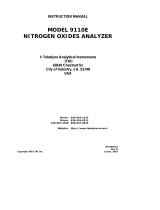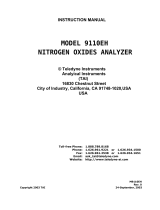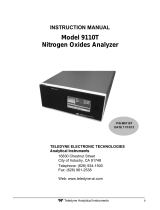Page is loading ...

User manual - MD-700 Series Nafion® Dryer
Large Diameter Dryer for Aerosol Analysis
Control Humidity in Your Samples Without Particle Losses
The MD-700 has been specifically developed for humidity control in particle measurement and aerosol analysis
applications. In order to minimize particle losses, a laminar sample flow should be maintained through the flow
path of the dryer. The MD-700 addresses these performance needs while providing the moisture removal
necessary to make accurate measurements across a wide range of flow rates. All moisture is removed in the
vapor phase with a purge gas flow.
Some features and benefits of the dryer:
• Low Particle Losses — Large diameter Nafion® tubing maintains a laminar flow of the sample through
the dryer.
• Eliminate Heating — Volatile particulates are preserved in the sample by eliminating the need to heat
the sample to control RH.
• Low Service Costs — Eliminates the need to repeatedly replace desiccant.
• Three Modes of Operation — Designed for use with instrument air, vacuum purge or partial reflux
methods.
• Stainless Steel Construction — Grounded Stainless Steel construction eliminates build up of static
charges in the flow path.
• Long Service Life — Replaceable Nafion® dryer elements are available to extend service life.
• Available in four sizes for specific flow rates:
o 15 cm (6”) – 0-1.5 lpm
o 30 cm (12”) – 1.5-4 lpm
o 60 cm (24”) – 3-8 lpm
o 90cm (36”) – 6-12 lpm
o 120 cm (48”) – 8-16.7 lpm
Perma Pure LLC 8 Executive Dr. Toms River, NJ 08755
T +1-732-244-0010 F +1- 732-244-8140 www.permapure.com E info@permapure.com
Page 1 of 5 Rev. 10/2014

User manual - MD-700 Series Nafion® Dryer
Large Diameter Dryer for Aerosol Analysis
• Performance curves shown below are for the 60 cm (24”) and 120cm (48”) versions operated in 80% reflux
mode (80% of the sample flow is returned to the dryer for used as the purge gas) at 25° C ambient
temperature.
Operating condition limits –
• Pressure -
o Maximum of 1000 mbar (15 psid) positive pressure differential between the sample gas and
purge gas volumes (higher pressure on the sample volume).
o Maximum of 200 mbar (3 psid) negative pressure differential between the sample gas and purge
gas volumes (higher pressure on the purge volume).
• Temperature –
o 0-40° C range
• Humidity –
o 0-99% RH (non-condensing)
Perma Pure LLC 8 Executive Dr. Toms River, NJ 08755
T +1-732-244-0010 F +1- 732-244-8140 www.permapure.com E info@permapure.com
Page 2 of 5 Rev. 10/2014

User manual - MD-700 Series Nafion® Dryer
Large Diameter Dryer for Aerosol Analysis
Modes of operation -There are three typical modes used to purge the dryer of water vapor. Each of the modes
has its advantages and disadvantages but all are simple to configure and operate. In each case, the outlet
humidity can be changed by adjusting the purge vacuum level and or flow. Typically, in the case of the split
sample and reflux modes, higher purge vacuum reduces sample gas outlet humidity and lower purge vacuum
increases sample gas outlet humidity.
"Reflux" mode employs a vacuum pump to purge the dryer. In this mode, a portion to 100% of the dry sample
gas that is exhausted from the analyzer is returned to the dryer, expanded through a needle valve or other flow
restrictor, and used as the purge gas. This requires a tube in addition to the sample gas tube to be connected to
the analyzer.
• Schematic Diagram – Reflux
• Purge vacuum range: 20in-hg vacuum (336 millibar abs.) to full vacuum
Notes:
1. If the analyzer incorporates its own sample gas pump, it is recommended that the outlet be vented to atmosphere as
shown. This will ensure that the pressure in the analyzer is not affected in the event the analyzer’s sample pump and the
purge vacuum pump are operated at different flow rates. Depending on the purge vacuum pump performance curve,
controlling the purge flow rate at a lower level than the analyzer sample flow rate will be desireable and will increase
drying performance.
2. If the analyzer does not incorporate its own sample gas pump, the dryer purge vacuum pump may be used to draw the
sample gas through the entire circuit. In this case,the atmospheric vent must be closed.
"Split Sample" mode is essentially the same as the "reflex "mode except the sample gas is split into two flows
after it exits the dryer. One stream flows to the analyzer and the other stream flows back to the dryer to be used
as the dryer purge gas. The main advantages of this mode over the reflux mode are only one tube is needed to
run to the analyzer, the drying process is independent of the analyzer, and none of the sample gas needs to be
returned to the dryer once it exhausts from the analyzer. The disadvantage is that this creates the need for
additional sample flow through the dryer to be used as purge gas. To maintain a similar level of drying
performance to that of the reflux mode, there is a need for a somewhat larger vacuum pump that can generate
a deeper vacuum. In order to optimize drying performance, the dryer purge flow rate must be minimized as to
not unnecessarily increase the total flow rate through the dryer. This also allows the pump to generate purge
vacuum that is as deep as possible.
See notes
Perma Pure LLC 8 Executive Dr. Toms River, NJ 08755
T +1-732-244-0010 F +1- 732-244-8140 www.permapure.com E info@permapure.com
Page 3 of 5 Rev. 10/2014

User manual - MD-700 Series Nafion® Dryer
Large Diameter Dryer for Aerosol Analysis
Schematic Diagram – Split Sample
• Purge vacuum range: 25in-hg vacuum (167 millibar abs.) to full vacuum
"Normal" mode is the most basic configuration. There are no moving parts and it is quieter than having a
vacuum pump running continually but requires that instrument grade air be available for use as the dryer purge
gas. In general, more purge flow reduces sample gas outlet humidity, less increases sample gas outlet humidity.
• Schematic Diagram – Normal
• Purge air humidity: Oil-less air, Instrument grade air is required, -40° C range dew point or below.
• Purge air flow rate: 2x the sample flow rate. (Additional flow will be of little or no benefit)
Perma Pure LLC 8 Executive Dr. Toms River, NJ 08755
T +1-732-244-0010 F +1- 732-244-8140 www.permapure.com E info@permapure.com
Page 4 of 5 Rev. 10/2014
/















